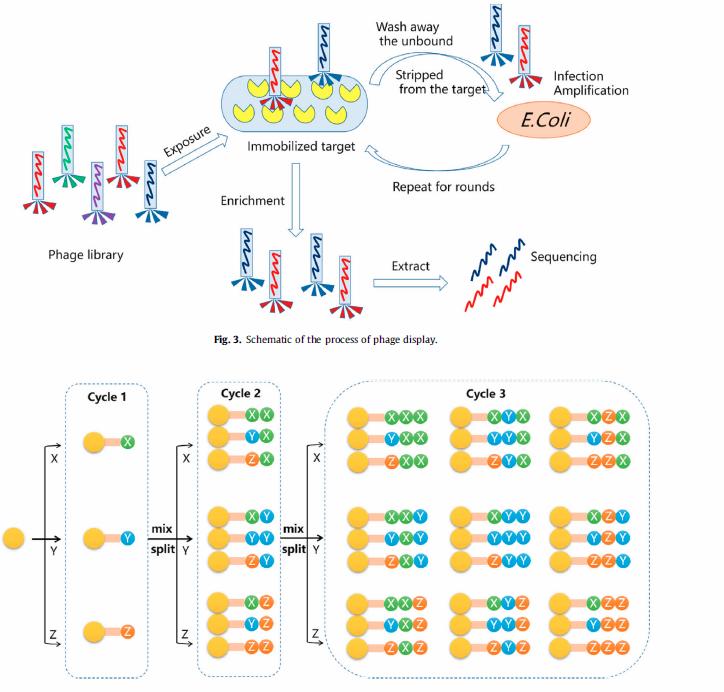Cell targeting peptides, referred as CTPs, have a good capacity to target the specific targets and thus have potential to deliver payloads specifically. The mechanism of most CTPs action has been investigated relatively clearly. CTPs always have good affinity with specific receptor in cells and the overexpression of such receptor causes CTPs homing largely to the cells. As a result, CTPs can be an efficient tool to delivery payload drugs such as molecular drugs and peptides specifically through a conjugate strategy. In the past few decades, a large number of CTPs have been discovered from natural proteins, or by combinatorial chemistry and computer-aided methods.
Integrin-targeting peptides: Arginine-Glycine-Aspartic acid (RGD) is one of CTPs reserachers found at the earliest. In addition, many RGD-related peptides have been developed successively, making RGD-related peptides become a large group of CTPs. Integrins are a family of transmembrane heterodimeric adhesion receptors which are involved in many physiological and pathological processes including adhesion, proliferation, migration, vascular leakage, inflammation and so on.
APN/CD13-targeting peptides: Another peptide sequence that targets tumor vessels is Asparagine-Glycine-Arginine (NGR). In 1998, Arap et al. Screened and found an Asn-Gly-Arg motif could bind specifically to CD13 (also called aminopeptidase N, APN) receptor on the cell surface, homing to tumor blood vessels. Similar to RGD, cyclic NGR was demonstrated much more potent than linear ones.
Lymphatic vessels-targeting peptides: In 2002, first lymphatic vessels-targeting peptide Lyp-1 was identified by Pirjo and coworkers. In their research, they used phage display method to screen on MDB-MB-435 breast carcinoma xenografts obtaining the cyclic 9-amino-acid peptide. They found Lyp-1 accumulated in the nuclei of the putative lymphatic cells and the nuclei of tumor cells, showing the potential to be used for target therapies into tumor lymphatics.
Hormone-based peptides: Luteinizing hormone-releasing hormone (LHRH, also GnRH) is a 10-amino acid peptide released by hypothalamus and is of great significance to reproductive regulation. LHRH receptor is overexpressed in prostate cancer, breast cancer, ovarian cancer, etc. Lots of LHRH analogues have been discovered, both LHRH agonists and antagonists could target to the receptor so that they can be used as carrier for delivering other drugs.
Specific tumor-targeting peptides: In 2002, Mohsen et al. identified a cell-targeting peptide LTVXPWY, a sequence exhibiting a specific binding to breast cancer cells, by using random peptide phage libraries. Then an antisense phosphorothioate oligonucleotide against ErbB2 (also called HER2) receptor was linked to this peptide and specific delivery of antisense oligonucleotide was achieved resulting in inhibiting the ErbB2 gene expression.
Phage display technology: Phage display technology is a powerful biotechnology for screening and modifying functional peptides and proteins, widely used in proteomics, antibody and peptide screening, gene cloning and etc.
One-bead-one-compound (OBOC) combinational chemistry: Combinational chemistry is becoming an increasingly important tool in constructing huge compounds libraries and identifying positive hits from them. The strong demand for efficient and prompt screening and identification led to the development of many combinational methods. One-bead-one-compound (OBOC) is such a method rapidly synthesizing and screening compound libraries of enormous structural diversity.
 Diagram of one-bead-one-compound used to construct compounds library (Zhou J, et,al. 2021)
Diagram of one-bead-one-compound used to construct compounds library (Zhou J, et,al. 2021)
Docking and virtual screening: Nowadays peptideprotein docking has become a useful strategy to discover the peptides acting on the specific target. It is usually categorized into two strategies: local docking and global docking.
De novo peptide design: Aside from docking and virtual screening, de novo design of peptides has been developed gradually.
Reference